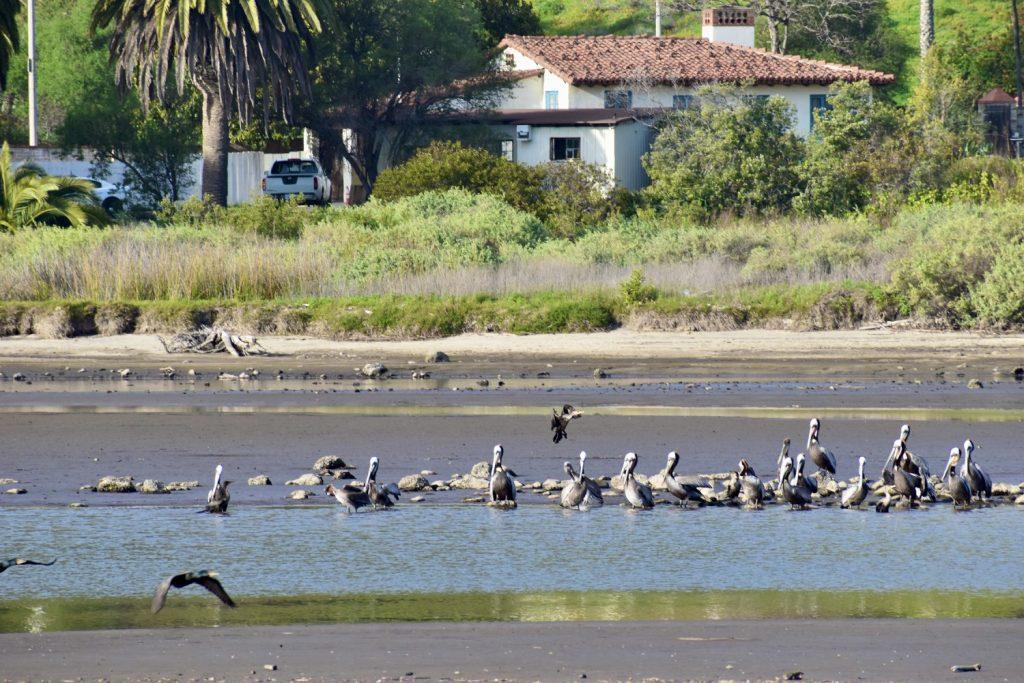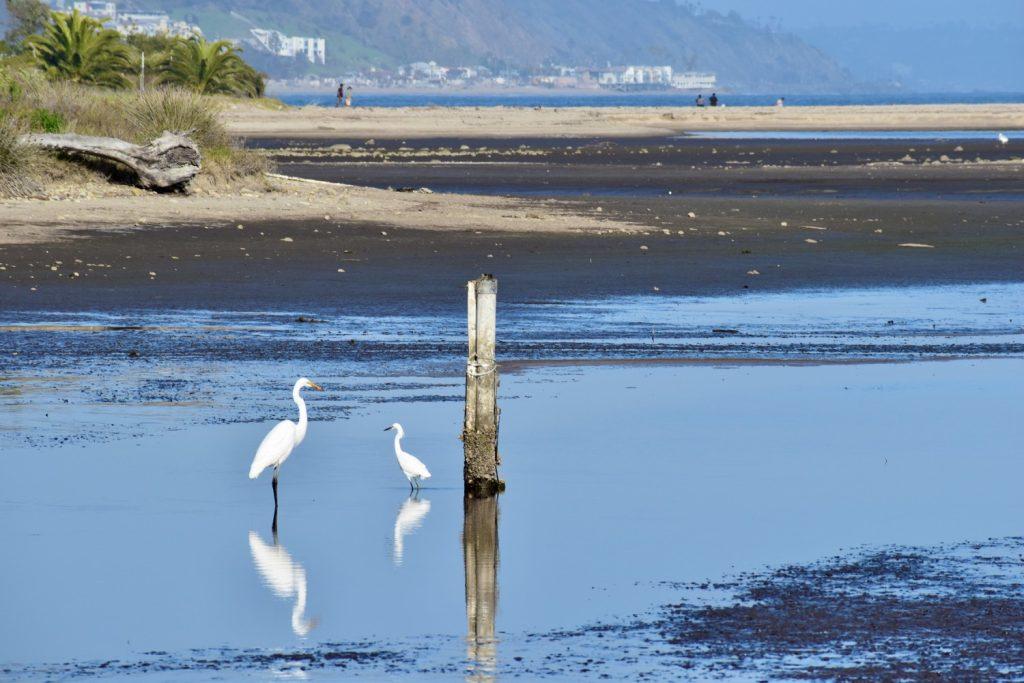Nestled along Pacific Coast Highway lies one of Malibu’s greatest treasures. From the highway, most travelers speed past, unaware that just beyond the ocean’s break lies a hidden ecological gem, teeming with life and natural wonder.
The Malibu Lagoon, an estuary and dynamic wetland, serves as a crucial habitat for diverse wildlife — including migratory birds, native fish and rare plant species.

The lagoon welcomes visitors daily, from surfers carving waves at Third Point Surf Break to ecologists studying its rich habitat. Open from sunrise to sunset, it invites all to experience its natural beauty.
“The lagoon is such a beautiful place to visit,” said Sienna Vassilev, a first-year Biology major and a member of the Pepperdine Surf Team. “I always walk by it on my way to surf.”
Although the lagoon appears serene on the surface, it faces a significant threat following the Palisades Fire that broke out Jan. 7. The diverse fauna inhabiting both beneath and above the water may be in danger as runoff from the fires contaminates the aquatic environment and climate change intensifies, Biology Professor Karen Martin said.
Before the Fires
The lagoon, which is a 31-acre shallow water estuary discovered in 1542, is the second-largest watershed draining into Santa Monica Bay, according to The Bay Foundation.
In 2010, the beach near the lagoon was dedicated as the first World Surfing Reserve, which means that it protects surfers and the environment, according to Save the Waves Coalition. The beach attracts approximately 1.5 million visitors a year, according to The Bay Foundation.
The lagoon underwent a restoration project in 2013, which led to the planting of thousands of native wetland plants. Martin, who specializes in beach management, conservation of shore ecosystems and coastal marine animals, said the lagoon is looking much better.
“The water quality is better than it was before the restoration,” Martin said. “The life within the lagoon is better and life in the terrestrial area around the lagoon, the plants, the birds, the other creatures that are out there are also much healthier than they used to be.”
Before Martin retired from Pepperdine, she said she took every opportunity she could to go and visit the lagoon with her students.
“In a very small area, very close to the university, you have just a tremendous resource of lots of different things in one place,” Martin said. “It is really great to have that opportunity for Pepperdine students to go there.”
William Ortler, senior Sustainability major and member of the Surfrider Foundation, said he spends a lot of time at the lagoon. The Surfrider Foundation is a nonprofit environmental organization dedicated to the protection and enjoyment of the world’s oceans.
“I like to learn a lot about the ecology in that area, as well as just kind of the biology there because it is a big biodiversity hotspot,” Ortler said.
The lagoon is home to a diverse array of avian life, hosting 100 different bird species, including brown pelicans, alongside numerous fish species such as the tidewater goby, Martin said.

Post Fires
Wildfires like the Woolsey, Franklin and Palisades fires have threatened the plants and animals of Malibu Lagoon.
“The ash from the fire will find its way into the water, and then it all funnels its way where the Malibu Lagoon is at,” Ortler said.

Ash, soot and other toxic materials can lead to significant respiratory issues in animals, triggering a trophic cascade that impacts these creatures, Ortler said. A trophic cascade is an ecological phenomenon where changes in the population of predators cause significant, indirect effects on organisms at lower trophic levels, altering the structure and balance of the entire ecosystem.
The tidewater goby, an endangered fish species only found in California, is especially threatened from the ash. In the 1980s, researchers noticed the gobies were vanishing from many estuaries, according to CSU Channel Islands, and with the amount of water toxins post-fires, the gobies could potentially vanish from the lagoon completely.
Researchers from Malibu and Topanga are enacting a solution to help the goby population post fires, Martin said.
“They collected a bunch of the endangered fish that lived there, the tidewater gobies, and removed them and put them in aquariums until the area becomes less toxic,” Martin said. “Once they’re safe, they’ll be returned back to their native habitat.”
Gobies, Martin said, are not the only animal significantly impacted by the fires.
“The young brown pelicans feed in the lagoon, and learn how to do their pledge diving there,” Martin said.
With debris contaminating the water, Martin said the young brown pelican is at risk of ingesting soot, which could lead to severe digestive issues.
Other Threats to the Lagoon
Fires aren’t the only threat to the lagoon. Heavy rainfall between January and February had a damaging impact, stirring up sediment and making the ocean and lagoon appear to merge, Vassilev said.
For Vassilev, this merger affected her ability to surf at Malibu Third Point, the break right across from the lagoon.
“The breaks used to be better before all this rainfall,” Vassilev said. “One thing I’ve noticed especially is how the lagoon feels more connected to the ocean than it was before. Now the lagoon will dry up with the tide, whereas it used to be full 24/7.”
The influx of ocean water can improve or degrade the water quality of the lagoon, depending on the ocean’s condition. This can influence nutrient levels, clarity and pollution in the lagoon, according to the National Oceanic and Atmospheric Administration.
Human development along PCH can also damage the lagoon.
“There’s been a lot of development, not only within Malibu, but also like higher up in the Malibu watershed,” Ortler said. “And when that development happens, whether it’s building new roads or, like, moving mountainsides or whatever, a lot of that erosion and sediment from higher up in the watershed is going to find its way into the lagoon.”
Next Steps for the Lagoon
Ortler said numerous measures have been implemented to conserve the lagoon, protect the species that inhabit its surroundings and educate people about the sanctuary’s importance.
“I think it’s important for us to know our community and like what surrounds us, whether it’s not just the beach, but what kind of the beaches and how life lives there,” Ortler said.
The Surfrider Foundation organizes regular beach cleanups following catastrophic events such as fires or storms, enabling students to assist in maintaining the cleanliness and health of the lagoon and other natural resources in Malibu, Ortler said.
“First one we did was after the storms last year, and we actually got a lot of trash that washed up on shore after the storms, and then we had one recently,” Ortler said.
The Santa Monica Bay Audubon Society also does bird walks that are open to anyone, Martin said.
“Pepperdine students and anybody that lives in the area can come down and join in the walks and learn more about the birds that live there,” Martin said.
The Malibu Lagoon is more than just a picturesque natural reserve; it is an ecological sanctuary that demands attention and care, Martin said.
“It is really great to have that opportunity for Pepperdine students to go [to the lagoon], we just have to take care of it,” Martin said.
___________________
Follow Currents Magazine on X: @PeppCurrents and Instagram: @currentsmagazine
Contact Alexa McGlathery via email: alexa.mcglathery@pepperdine.edu
